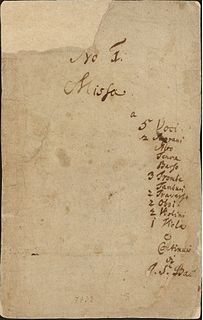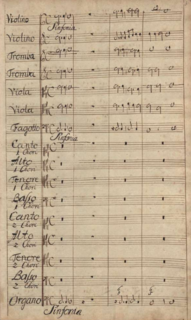Related Research Articles

Claudio Giovanni Antonio Monteverdi was an Italian composer, string player and choirmaster. A composer of both secular and sacred music, and a pioneer in the development of opera, he is considered a crucial transitional figure between the Renaissance and the Baroque periods of music history.

Giovanni Pierluigi da Palestrina was an Italian Renaissance composer of sacred music and the best-known 16th-century representative of the Roman School of musical composition. He had a long-lasting influence on the development of church and secular music in Europe, especially on the development of counterpoint, and his work is considered as the culmination of Renaissance polyphony.
A madrigal is a secular vocal music composition of the Renaissance and early Baroque eras. Traditionally, polyphonic madrigals are unaccompanied; the number of voices varies from two to eight, and most frequently from three to six. It is quite distinct from the Italian Trecento madrigal of the late 13th and 14th centuries, with which it shares only the name.

Antonio Lotti was an Italian composer of the Baroque era.

Giovanni Maria Artusi was an Italian theorist, composer, and writer.

Giulio Romolo Caccini was an Italian composer, teacher, singer, instrumentalist and writer of the late Renaissance and early Baroque eras. He was one of the founders of the genre of opera, and one of the most influential creators of the new Baroque style. He was also the father of the composer Francesca Caccini and the singer Settimia Caccini.
Bartłomiej Pękiel was a notable Polish composer of classical music.
Seconda pratica, Italian for "second practice", is the counterpart to prima pratica and is sometimes referred to as Stile moderno. The term "Seconda pratica" first appeared in 1603 in Giovanni Artusi's book Seconda Parte dell'Artusi, overo Delle imperfettioni della moderna musica, where it is attributed to a certain L'Ottuso Accademico. In the first part of The Artusi (1600), Artusi had severely criticized several unpublished madrigals of Claudio Monteverdi. In the second part of this work, L'Ottuso Accademico, whose identity is unknown, defends Monteverdi and others "who have embraced this new second practice". Monteverdi adopted the term to distance some of his music from that of e.g. Giovanni Pierluigi da Palestrina and Gioseffo Zarlino and to describe early music of the Baroque period which encouraged more freedom from the rigorous limitations of dissonances and counterpoint characteristic of the prima pratica.

The concerto delle donne was a group of professional female singers in the late Renaissance court of Ferrara, Italy, renowned for their technical and artistic virtuosity. The ensemble was founded by Alfonso II, Duke of Ferrara, in 1580 and was active until the court was dissolved in 1597. Giacomo Vincenti, a music publisher, praised the women as "virtuose giovani", echoing the sentiments of contemporaneous diarists and commentators.
The year 1613 in music involved some significant events.
The year 1603 in music involved some significant events.
Musical historicism signifies the use of historical materials, structures, styles, techniques, media, conceptual content, etc., whether by a single composer or those associated with a particular school, movement, or period.

Le nuove musiche is a collection of monodies and songs for solo voice and basso continuo by the composer Giulio Caccini, published in Florence in July 1602. It is one of the earliest and most significant examples of music written in the early baroque style of the seconda pratica. It contains 12 madrigals and 10 arias.
Benedetto Pallavicino was an Italian composer and organist of the late Renaissance. A prolific composer of madrigals, he was resident at the Gonzaga court of Mantua in the 1590s, where he was a close associate of Giaches de Wert, and a rival of his younger contemporary Claudio Monteverdi.

Baroque music is a period or style of Western art music composed from approximately 1600 to 1750. This era followed the Renaissance music era, and was followed in turn by the Classical era. Baroque music forms a major portion of the "classical music" canon, and is now widely studied, performed, and listened to. Key composers of the Baroque era include Johann Sebastian Bach, Antonio Vivaldi, George Frideric Handel, Claudio Monteverdi, Domenico Scarlatti, Alessandro Scarlatti, Henry Purcell, Georg Philipp Telemann, Jean-Baptiste Lully, Jean-Philippe Rameau, Marc-Antoine Charpentier, Arcangelo Corelli, Tomaso Albinoni, François Couperin, Giuseppe Tartini, Heinrich Schütz, Giovanni Battista Pergolesi, Dieterich Buxtehude, and Johann Pachelbel.
Most of Johann Sebastian Bach's extant church music in Latin —settings of the Mass ordinary and of the Magnificat canticle— dates from his Leipzig period (1723–50). Bach started to assimilate and expand compositions on a Latin text by other composers before his tenure as Thomaskantor in Leipzig, and he continued to do so after he had taken up that post. The text of some of these examples by other composers was a mixture of German and Latin: also Bach contributed a few works employing both languages in the same composition, for example his early Kyrie "Christe, du Lamm Gottes".
Pietro Torri was an Italian Baroque composer.

The Mass in B minor is Johann Sebastian Bach's only setting of the complete Latin text of the Ordinarium missae. Towards the end of his life, mainly in 1748 and 1749, he finished composing new sections and compiling it into a complex, unified structure.

The Kyrie–Gloria Mass for double choir, BWV Anh. 167, is a mass composition in G major by an unknown composer. The work was likely written before the second quarter of the 18th century. In the 1730s Johann Sebastian Bach produced a manuscript copy of the Mass. In the early 19th century, it was published and performed as a composition by Bach. Scholarship published in the second half of the 19th century contested the work's attribution to Bach.

Pietro Torri's Magnificat in C major for double choir and orchestra likely dates from the 1690s. The work is scored for two SATB choirs, two trumpets, bassoon, strings and basso continuo. The work opens with an instrumental introduction (sinfonia). Most of its movements are either choral movements, in which all singers and instruments participate, or duets for two singers and a more limited instrumental accompaniment.
References
- Claude V. Palisca. "Prima pratica", Grove Music Online , ed. L. Macy (accessed March 19, 2006), grovemusic.com (subscription access).
- Grout, Donald J. A History of Western Music (6th ed.), W.W. Norton and Company, New York, 2001. ISBN 0-393-97527-4
- Wolff, Christoph (1968). Stile antico in der Musik Johann Sebastian Bachs: Studien zu Bachs Spätwerk[Stile antico in the music of Johann Sebastian Bach: Studies on Bach's late work]. Beihefte zum Archiv für Musikwissenschaft (in German). VI. Wiesbaden: Steiner. OCLC 651793960.